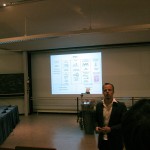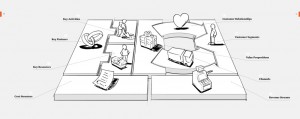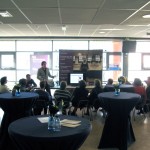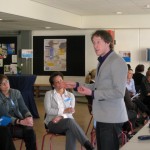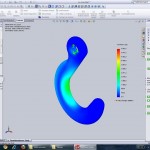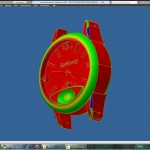Extra curricular
Lecture Business Model Inc.
April 2010 I attended to a guest lecture from Patrick van der Pijl and Camillia van den Boom concerning their company Business Model Inc. and the book Business Model Generation (see their website). During the lecture, I gain insight how to visualize business models as well how to come up with improvements concerning the current market-situation.
I learned a crucial starting point is a concrete vision (what do you want?) and subsequently is to look critical at the environment and context, in order to see how to achieve that vision. Van der Pijl introduced a very useful tool to visualize the current business model into a canvas. This canvas contains aspects of the entire business model, like value proposition, customer segments, key partners, cost structure etc. During the lecture, we tried out the tool ourselves by using it for Skype and KPN and comparing them. You can see a picture of their business model on the right side:
I learned this canvas could be a very useful tool as a designer to get insight how and where to improve the current business model. Furthermore, this canvas could be a starting point for a new innovative business model. In addition, companies can determine several business models to forefront changes on the market. Furthermore, I learned current business market is shifting towards a more service related: Tailor-made and personalized “co-creation” sessions are upcoming business. These are important things to keep in mind as a designer. This tool can builds on the knowledge gathered from the assignments Assignment DA511 The Context of New Product Development and Assignment DG502 – Analysing and Modelling NPD: Medical Systems and can be combined with the assignment Assignment DG505 – Financial and Economical Aspects of Product Design I did current semester.
Workshop elevator pitch by René de Torbal
During the IDentity-week I attended to the workshop Elevator Pitch by René de Torbal. During this workshop, I learned useful tips for a proper elevator pitch. An elevator pitch is a concrete summary that can be told within the time of using the elevator. I learned that before staring a pitch, I have to look at the business case; what is the idea and to whom it is appealing? The good structure for a pitch is mentioning the problem, the solution and at least three reasons why to buy. I also learned while presenting it is important to be aware of the content, “me” (my attitude, intonation, use of presentation space) and “you” (enhancing the audience). It is useful to ask the audience questions concerning problems they might face and why this solution is useful for them. I became aware it is essential to focus on the benefits, rather than the features. This workshop learned me how to forces myself to think in a concrete way concerning the design (what is the problem, how does my solution tackle it and why should users use my solution (and not the competitor’s))?
I took this information in mind while I presented at the final exhibition and while I presented my previous graduation project for 180 people at the congress “Zorg & Techniek” at ROC Eindhoven (see http://www.zorg-technologie.nl/congres2010/verslag.php and http://www.roceindhoven.nl/home/nieuws/nieuws-2010-b/Succesvol-congres–Persoonlijke-Zorg–da-s-toch–t.html).
AutoDesk Inventor 2010 and Solidworks 2010 SimulationXpress
During my internship project, I sometimes got some questions concerning the strength of the material, and which forces the design could endure. Therefore, I decided to do some tutorials with AutoDesk Inventor 2010 and Solidworks 2010 SimulationXpress, in order to simulate applied forces, constraints, materials on designs. This activity taught me to give Mechanical Engineering approaches of design analysis. Some examples are shown below and a small animation can be shown here.
Screenshots of stress analyses using software (click to zoom)
Literature
 In my spare time I read a few books concerning designing. The most interesting one was ‘Handbook Ontwerpen’ (Design Manual) (2nd press) by P.Delhoofden. This book broaden my horizon concerning the practical issues I have to face as Industrial Designer. This book learned me new design techniques as DFA and DFA how to perform structured projects, integrating multiple aspects, mechanical engineering and design practice. I also learned new tools like TRIZ as ideation tool, became more aware of the financial aspects and Dutch patent systems. The book also contained assignments to practice the gathered knowledge, which was very educative.
In my spare time I read a few books concerning designing. The most interesting one was ‘Handbook Ontwerpen’ (Design Manual) (2nd press) by P.Delhoofden. This book broaden my horizon concerning the practical issues I have to face as Industrial Designer. This book learned me new design techniques as DFA and DFA how to perform structured projects, integrating multiple aspects, mechanical engineering and design practice. I also learned new tools like TRIZ as ideation tool, became more aware of the financial aspects and Dutch patent systems. The book also contained assignments to practice the gathered knowledge, which was very educative.
